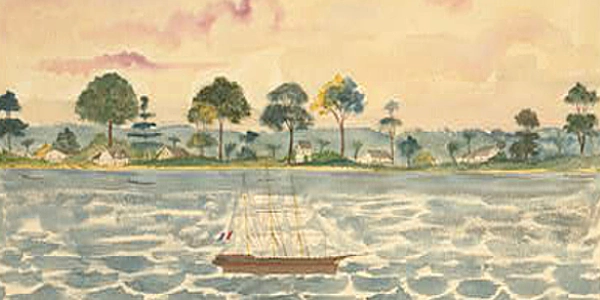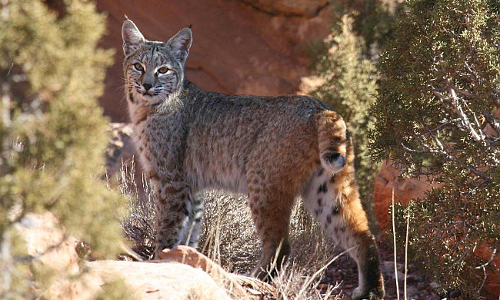Sponsor this page. Your banner or text ad can fill the space above.
Click here to Sponsor the page and how to reserve your ad.
-
Timeline
1822 Detail
January 7, 1822 - The first group of freed American slaves settle a black colony known as the Republic of Liberia when they arrive on African soil at Providence Island. The capital, Monrovia, is named after President James Monroe.

Over eighty former American slaves, freed, had left New York City on February 6, 1820 on the ship Elizabeth for Sierra Leone, hoping to establish a separate colony for themselves, assisted by the American Colonization Society. It was an awkward attempt at emancipation by repatrioting African Americans to the continent of their ancestors. The concept would be popular with various elements in the abolitionist society as an option to pure emancipation and freedom in all of the United States, which was decades away from occurring. It was supported by Quakers, who believed that free blacks would face better prospects in their homeland. It was also supported by slaveholders who thought freed slaves should be repatriated as a way to halt slave rebellions.
The first two years had not gone well. In 1820, their settlement on Sherbro Island became untenable, with the remainder returning to British territory on a temporary basis, allowed by the British governor. The British backed colony of Sierra Leone had been established in 1787 as the Province of Freedom for poor blacks, four hundred, and some whites, sixty, transported there from London. After the British attempt had trouble with the native population, the Temne, who resisted the new arrivals, the first settlers were reduced in number to sixty-four. Twelve hundred Black Loyalists of the British in the American Revolution, previously settled in Nova Scotia, joined them in 1792. Five hundred and fifty-one more arrived from Jamaica in 1800. So when the American freed settlers arrived back in Sierra Leone, they were now subject to the tenants of Sierra Leone, a British Crown colony since 1808, and still not living in a free colony of their own.
In 1821, the American Colonization Society sent two representatives to find a suitable location, Dr. Eli Ayres, who awaiting assistance from Naval Lieutenant Robert Stockton, who commanded the U.S. Schooner Alligator. They traveled up the coast north of Sierra Leone to an area west of Grand Bassa and began to negotiate on December 12, 1821 with the Dey and Bassa people of the Cape Mesurado area. However, the tribe that controlled the island of Mesurado under their chief, King Peter, were persuaded, perhaps at the point of a gun, although that is unknown and perhaps conflated with the general knowledge of the tribe that Stockton had captured French vessels involved in the slave trade with that tribe itself, to surrender a thirty six mile long and three mile wide stretch of land for three hundred dollars worth of supplies, weapons, and rum. The contract was signed December 15, 1821.
"I consider our contract not only as a triumph over savage prejudice, but over European negotiation. For this you are en tirely indebted to the energy , sagacity , and perseverance of Lieut. Stockton. We have purchased a tract of country containing one million of dollars' worth of land, with the best harbour between Gibraltar and the Cape of Good Hope, an Island containing nine houses, and six others to be built; there are excellent springs of water near the site we have selected for a city; and at the pitch of the Cape, there is an excellent place for watering ships. All this we have purchased in fee simple for little more than was stipulated to be given for the annual rent of Bassa, and not amounting to more than three hundred dollars. The Island at the month of the river we have named "Perseverance," to perpetuate the long and tedious palaver we had in obtaining it," Dr. Eli Ayres.
Additional colonists arrived from the United States at the beginning of 1822. On January 7, 1822, the second attempt, with Dr. Eli Ayres in command, was made to establish Liberia when his ship arrived at Cape Mesurado. On April 25, 1822, the original colonists, survivors of Sherbro Island, arrived, and formal possession of the land was taken with American colours raised. The settlement would be known as Christopolis.
Establishing Christopolis
The settlement of Christopolis was located on Providence Island at the mouth of the Mesurado River. Within several weeks of their arrival in April, twenty-two dwellings had been constructed. On August 8, 1822, the colony was governed by Jehudi Ashmun, a Methodist missionary and the successor to Dr. Eli Ayres at Christopolis, as representative of the American Colonization Society. An authoritarian, Ashmun created tension and disagreements with many of the colonists. By 1823, their disagreements had come to the forefront. The settlers argued against his unfair allotment of land and supplies, taking up arms against Ashmun, and forcing him to flee.
American Colonization Society representatives calmed the situation with Jehudi Ashmun returning. New laws and rules were established, including the Liberian Constitution. The agent of the American Colonization was bound to rule by common law. There would be no slavery and no involvement in the slave trade.
Christopolis is now known as Monrovia, named after President James Monroe in 1824, and the colony in total named Liberia. Over the next ten years, the settlement would grow with new Freed African Americans that would number two thousand six hundred and thirty-eight. Other settlements for free American slaves were also established, often by state colonization societies with less than noble goals. Repatriation and colonization of these African colonies was controversial, even when supported by those with more lofty ideals, including politicians such as Abraham Lincoln, Henry Clay, and James Monroe.

Who was Robert F. Stockton
Robert Field Stockton was a Navy lieutenant in 1821 when he assisted in the selection and negotation of the site for the colony. He had been a midshipman in the Navy as of September 1811 and fought in the War of 1812. After the war, he commanded ships in the Mediterranean, Caribbean, and off the coast of West Africa. He is credited with being the first commander to take action against the slave trade, capturing several slave ships.
After leaving the Navy to engage in business pursuits, Stockton returned to the Navy as a captain in 1838. During the Mexican War, Commodore Stockton became the commander of the Pacific Squadron, and became the driving force behind possession of Alta California from Mexico, becoming military governor in 1847. He would be elected to the U.S. Senate after retiring from the Navy and be a delegate, after resignation from the Senate, during the unsuccessful Peace Conference of 1861, which attempted to solve the secession crises that would prompt the American Civil War.
Image above: Watercolor drawing of Bassau Fish Town, Liberia, 1856, American Colonization Society Collection. Courtesy Library of Congress. Image below: Drawing of the mansion of President Joseph Jenkins Roberts, Monrovia, Liberia. Date unknown. Courtesy Library of Congress. Source Info: Wikipedia Commons; Library of Congress; Office of the Historian, Department of State; The Political and Legislative History of Liberia, 1847, Charles Henry Huberich; "January 7, 1822: First African American Colonists Arrive in Liberia," awb.com; Encyclopedia Britannica; onliberia.org.






